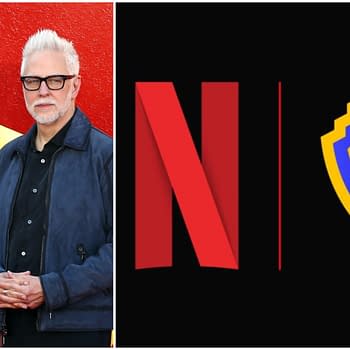Posted in: Comics, Recent Updates, Video | Tagged: andrew wheeler, no more mutants
No More Mutants #4 by Andrew Wheeler – Look To The Northstar
Welcome to the fourth instalment of No More Mutants, a series of columns looking at the representation of minorities in superhero comics. This week I'm going to cover a subject that I wasn't planning to touch for a while, because it's the subject I'm closest to, and therefore the easiest for me to write about. This week it may also be the hardest.
I grew up with superhero comics. I also grew up Catholic, and I also grew up gay. Those last two are an uncomfortable combination. Adolescence is awkward for everyone; struggling with one's sexual identity under the wagging brimstone finger of a disapproving Pope only adds to the pain. Even if you don't have the Pope to worry about, there are other social pressures that are especially pronounced in the lives of lesbian, gay and bisexual teens. They have to worry about acceptance from their family and their friends, from their community and even their government, and first and foremost they have to learn to accept themselves. It can be devastatingly hard to deal with.
I turned to superhero comics for my escape. The superhero genre is uniquely well tailored to adolescence; it offers empowerment fantasies for the underdogs and the ostracised, which is all of us at that age. Peter Parker is a nerd like you and me. Clark Kent has to hide what makes him great behind an everyday face so that he doesn't draw attention. Bruce Wayne's childhood pain gave him the discipline to survive and excel. Superheroes tell us that difference does not make us bad; it makes us better.
Yet there was one way in which all the heroes I read about were no different from each other, or from the majority. They were all straight.
Except Northstar, of course. Northstar came out in 1992 in the pages of Alpha Flight #106, in a manner that was at once ham-fisted and Kirby-handed, though his sexuality had first been hinted at almost a decade earlier. He was not the only gay character in comics, but he was the poster boy, both because he was a hero in an ongoing title, and because he uttered (or rather, shouted) the words, "I am gay".
Beyond a terrible coming out story, Northstar's sexuality has had little significance over the past two decades, and the character has kept a very low profile outside of stories where he was being killed off, or being killed off and then turned evil. For years his love life amounted to one fleeting appearance by a shadowy figure in his bedroom in one issue of his mid-90s limited series. This did not give gay audiences much to go on.
The driving theme of this column is that minority audiences should be represented in the media they consume. It's more honest than omission, it broadens the experience of our entertainment, and most importantly it encourages people in minorities to value themselves, and it encourages people in the majority to respect them. That is especially true for lesbian, gay and bisexual audiences. It's through visibility in the media that we learn that we don't have to be freaks and outcasts, and it's through the education and exposure that media provides that others learn to accept that we are not a threat to society, but a part of it.
In recent weeks there have been a number of teen suicides, all by kids who were bullied because they were gay, or because they were perceived as gay. Tyler Clementi is the best known of them. He leapt to his death from the George Washington Bridge on the Hudson River on September 22nd. He was 18. Seth Walsh was 13 when he took his own life. Billy Lucas was 15. Asher Brown was 13. Go back beyond the past few weeks and you can add Eric Mohat, 17, to that list. You can add Carl Walker-Hoover, 11; Jaheem Herrera, 11; Justin Aaberg, 15, and legion more.
Homophobic bullying is a serious and avoidable problem. This is a long buried truth that is finally getting the attention it deserves from journalists, government, and people in the public eye. Advice columnist Dan Savage led the response to these recent suicides with his It Gets Better project, wherein people record messages of hope for today's struggling teens. Contributors have included both gay and straight public figures, such as Neil Patrick Harris, Zachary Quinto, Kesha and Tim Gunn.
The comic book industry could play its part as well. In 2001 I wrote an open letter to the industry, which said;
"Many young people go through a very difficult stage of their lives when they have to come to terms with their own sexuality. Many of these young people face alienation by the people they love and need the most – their family and friends. Many of them don't make it. The suicide rate among gay teens is disproportionately high.
"What these kids need is for someone to show them it's OK. What they need is positive representation. It gives them a sense of belonging in this world, and every incidence of positive representation helps chip away at homophobia. Positive representation can change lives, or even save them. We need more gay characters in comics."
The intervening years and the events of recent weeks have only reaffirmed my position. Our best weapon against bullies has always been visibility, which brings education and respect.
In the same year that I wrote that letter, I attended a launch event for Ultimate X-Men, where I asked Mark Millar if he would correct a long-standing oversight. Although the X-Men books are all about prejudice and diversity, there had never been a gay X-Man up to that point. I said that the Ultimate version should do better.
I don't know if Millar was following my advice when he made the Ultimate version of Colossus a gay character, or if he had arrived at a similar idea independently, but he deserves full credit for giving the Ultimate universe its first gay character. This was only a year after Millar had run into censorship when a gay kiss between WildStorm's pioneering gay couple, Apollo and Midnighter, was cut from his Jenny Sparks limited series.
When I asked then-editor John Layman about this, he explained; "There are powers that be who are not completely comfortable with portraying a gay relationship, particularly since people outside comics still perceive it as a 'kid's medium'. … [T]he powers seem to be letting us take baby steps, and long as they are not completely shutting us down we will continue to play ball." Note that this kiss was in a comic aimed at 'mature readers'.
Here's the great gay paradox; homophobia is best tackled by greater gay visibility, and gay visibility is held back because of homophobia – most notably the pernicious claim that homosexuality does not belong in any medium that might be seen by children. This is grounded in a great misconception; that homosexuality is all about sex, while heterosexuality is all about love. This is only credible if you believe that gay people are incapable of love and straight people are incapable of lust. This seems like a stretch, yet it's the fundamental position behind the reflexive view that homosexuality does not belong in kid-friendly media.
As a result, same-sex relationships have become an adult 'taboo', and information has been restricted and ignorance has reigned. Kids growing up gay or questioning are condemned to self-doubt and bullying. The truth is that kids should be exposed to homosexuality, to the same manner and degree that they are exposed to heterosexuality, which is present in every 'boy meets girl' story ever told. This wild notion of representation based on reality is what bigots call 'the gay agenda'; an effort to end prejudice so that teenagers don't shoot themselves or hang themselves or throw themselves off bridges.
In the eighteen years since Northstar came out, and in the nine years since the first gay X-Man, the state of gay characters in comics has improved significantly. DC's gay roster now includes Renee Montoya, Batwoman, Grace Choi and Thunder. Just to prove that they're not solely obsessed with lesbians, they also have Obsidian and Creote. At Marvel, where Allan Heinberg initially tried to slip the relationship between Wiccan and Hulkling under the editorial radar, there are now several gay and bisexual characters, like Karma, Moondragon, Rictor and Shatterstar, and even gay teens like Anole and Karolina Dean.
In relative terms, it's only a drop in the ocean. Most of these characters are still fringe enough that they could disappear tomorrow. But hopefully these characters are just the start, and gay characters will become a normal fixture of our superhero comics; we should eventually see active gay members in the Avengers and the JLA, plus more story time given to established gay characters like Northstar and Batwoman, including romance, and we should see more gay characters being introduced all the time.
When that happens, we will know that we can be heroes. And when that happens, we will believe that it can get better.













